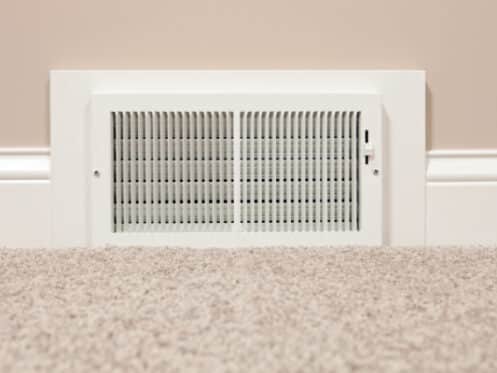Updated: August 2023
When you receive your utility bill every month, around 40-50% of it is likely tied up in the costs of heating and cooling your entire home. When temperatures begin to drop, your bill will get higher because of the larger demand for heat throughout your home. There are numerous systems that can be used to heat a home, one of which is an electric furnace. These systems can be installed on their own or alongside a heat pump. Knowing how an electric furnace works should make it easier for you to detect when the system isn’t functioning properly.
What Is an Electric Furnace?
The majority of residential homes throughout the U.S. use central air for their heating and cooling needs. Central air systems are equipped with a blower motor that’s positioned inside an air handler or furnace to obtain air from the home. At this point, the air is cooled or heated depending on the time of year before being sent back into the home via vents and ductwork. While propane or natural gas can be used for this purpose, it’s also common for residential homes to use electric furnaces to heat the home, which means that the furnace relies on electricity as opposed to natural gas.
What Is an AFUE Rating?
Before describing how electric furnaces work, you should know about annualized fuel utilization efficiency (AFUE) ratings. This type of rating refers to the amount of heat that’s produced for each dollar you spend. When a furnace comes with a high AFUE rating, you won’t need to spend as much money to heat your home. Most electric furnaces have AFUE ratings that approach 100%, which means that electricity can be converted into heat energy without needing to worry about wastage.
How Do Electric Furnaces Work?
To understand how an electric furnace works, you should first know how all furnaces operate. Any system that can warm a surrounding area is based on the principle that temperature can be transferred. When you place a kettle on top of an electric stove top, the stove will warm up and transfer the heat directly to the kettle. In doing so, the heat is transferred to the water as well, which allows it to be boiled for tea. In the event that your tea is hotter than you’d like it to be, an ice cube can be dropped in it to cool it down. In this scenario, the freezing water and warm tea transfer temperatures, which leads to a more manageable temperature in your cup of tea.
A heating system operates in the same manner. When a point of heat is made and air is drawn through it, the heat can be transferred to the air before it’s sent through the surrounding space. While wood-fired stoves can provide your home with a small amount of heat, they aren’t effective at heating larger areas since nothing is pushing the air into your home.
Modern electric and gas furnaces solve this problem by using the same principles detailed above while also making sure that the heated or cooled air can be distributed into the home with ductwork. If the thermostat in your home finds that the indoor air temperature has dropped below the required levels, a signal will be sent to the furnace to start the heating process. At this stage of the process, the heating element that’s present in the furnace will be activated to create warmth. The heating element in an electric furnace involves spools of wire that have been tightly coiled together. They are larger versions of what you can find in toasters. Once your thermostat sends an electric current to these coils, they will be heated up. If there’s a higher need for heat in your home, a higher number of heating elements will be activated.
Once the motor activates, it makes use of a blower system to bring in any cool outside air via a filter. The filter in your system is essential since it’s able to get rid of particulate matter like dust. Air filters come with a MERV rating that can go as high as 16. Higher ratings equal better air filtration, which means that more particles will be removed before the air gets distributed into your home. When the air passes over the aforementioned heating element, it will heat up to a higher temperature depending on how many of the elements have been activated. Since there aren’t any hazardous components found in the heating elements, you can be confident that it’s safe for air to pass over them.
Primary Parts and Features
All-electric furnaces have similar parts and features, which include everything from a heat relay to sequencers. The heating elements mentioned above are made from metal that’s resistant to electricity. This metal is typically a combination of chromium and nickel. Heat relays are able to determine how much electricity will be fed into the system’s heating elements.
The plenum is a relatively small air chamber in electric furnaces that collects the air and makes it easier for the air to be circulated in your home. An electrical transformer is a component that reduces all incoming voltage to a specific voltage that the furnace’s control elements can accommodate. In most cases, the incoming voltage is 240 volts, while the control elements support around 24 volts.
The blower is a motorized fan that’s capable of blowing cool air onto the heating element, which forces the air into nearby ducts and properly heats the building until the thermostat settings are reached. Return air ducts are designed to pull unheated air into the furnace, which occurs just before the blower fan pushes the air onto the heating element.
As detailed above, filters capture airborne particulate matter, which can include everything from dust to debris. By capturing these pollutants before they enter your indoor air, the air you breathe in your own home should be clean and healthy. Sequencers are available in all-electric furnaces that consist of more than one heating element. These components are able to control when each heating element is turned off and on, which ensures that the electrical load is evenly distributed. The thermostat you install in your home allows you to control when the blower fan and heating elements turn on and off. This process is fully automated based on the programmable settings you input.
Your Local Heating and Cooling Company
Our technicians at A/C & Plumbing Doctors can install, maintain, or repair your electric furnace. If you have an older gas furnace that you’d like to have replaced in your Gilbert, AZ home, we can help you choose a new electric furnace and install it once the purchase has been made. Along with electric furnaces, we can work with all other types of heating and cooling systems, which include heat pumps and ductless mini-splits.
Our residential services also extend to air handlers and ductwork. Whether the ductwork in your home needs to be cleaned or repaired, we’ll make sure that air is moving through the ducts efficiently. Request our indoor air quality services if you’d like to have your indoor air tested or a filtration system installed. Call us today to ask about our specials or schedule our services.





